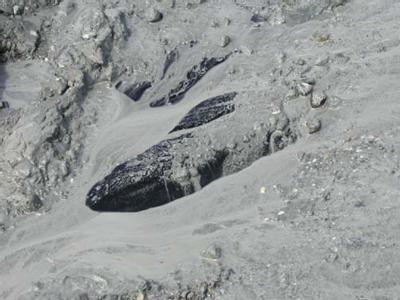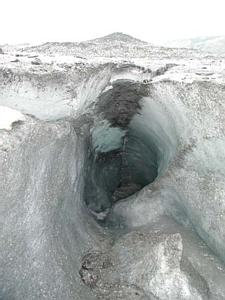17 July, 2000
July 17, 2000
Matanuska Glacier, Alaska
I knew very little about glaciers before coming to the Matanuska
Glacier. And to look at the big picture I will still know very little
when I leave. But I’m sure when I return to Indiana I will think about
all the things I will have seen and learned while here. I have known for
a long time that most of Indiana was once covered by a glacier coming
down from the north. But I never quite understood how it could travel
that far. I could understand how movement could occur in the pictures of
glaciers such as the Matanuska. After all it flows down from the
mountains. But there are no mountains even remotely near my home state.
How could this sheet of ice possibly move? To understand requires a
little understanding of the ice itself.
A glacier is basically an accumulation of ice, snow, water, rock and
sediment that moves under the influence of gravity across the face of
the earth. They are constantly changing in response to temperatures,
precipitation and other geologic processes. And it is the ice, snow and
water that take a central role in a glacier, powered by the force of
gravity and the energy of the sun. But it is mostly the ice that people
think about or see when they come to a glacier.
Glacier ice forms slowly and obviously starts out as simple snow. Soon
after the snow has fallen it changes rapidly through sublimation,
melting, crushing and compaction into nearly spherical granules of solid
ice, similar to what skiers call “corn”. This usually happens within a
few days to a few weeks. As more snow is added the pressure builds
resulting in changes in density, volume and crystal structure. In this
metamorphic process of changing ice to snow the volume can decrease up
to nine times its original value. The snow eventually turns into what is
called firn after it survives one summer melt season. As firnication
(the process of changing snow to firn to glacial ice) occurs the
original layering of the snow is lost and flakes merge and grow together
to make granules of solid ice. The original snow density (about 0.1
g/ml) has now increased to between 0.4 to 0.8 g/ml. A density of around
.55 g/ml is apparently the greatest that can be attained in old snow
just by shifting and settling so that they fit most snugly together.
Melting and refreezing, deformation and recrystallization will then
allow the grains to fit still more snugly together, reducing pore space
and permeability which results in increased density and compactness.
Eventually pore spaces are sealed off and the ice becomes impermeable.
At this point the density is near 0.82 to 0.84 g/ml. Under great
pressure solids can actually exhibit fluid properties. As a result,
enclosed pore spaces can get smaller due to the pressure compressing the
trapped gas as well. Pore spaces continue to shrink due to increased
pressures as more layers accumulate from above. The values reach an
upper limit near 0.9 g/ml which is common for glacier ice. The maximum
density of ice in pure crystals is 0.917 g/ml.
The air trapped in the ice is frequently subjected to pressures up to
750 pounds per square inch. The air contained in these bubbles is
studied closely by scientists interested in studying the history of the
earth’s atmosphere. Other entrapped parcticles such as volcanic ash or
pollen tell other stories of the earth’s past. When glacial ice melts
the pressurized bubbles break producing a resounding pop. When hundreds
of these bubbles break almost together it can sound a bit like Rice
Krispies cereal. This is known as “ice sizzle” or “bergy seltzer”.
There’s a story about some glaciologists celebrating the completion of
an ice core that was drilled to more than 2000 feet. Ice from the bottom
of the core was used to chill some liquid refreshments. Soon glass after
glass cracked under the impact of the bursting high energy bubbles. I
have not noticed this sound here yet. Perhaps it is masked by the winds
or is imperceptible to my hearing ability.
In another journal I will look at how this ice moves and travels, in
some cases all the way to Southern Indiana. There are clues to this
process in this journal entry.
Marvin Giesting

Black ice surrounded by slowly flowing sheets of silt and sand. This ice would be completely clear if cut out of the glacier and held up to the light. In other locations on the glacier where there's little debris on the surface and light can get into the ice it would appear as various shades of blue. Blue and black ice, which are actually the same type ice under different lighting conditions, are as packed and dense as glacial ice can get.

Looking down into the chute of this moulin one can see the top two feet or so of ice is white. This ice near the surface has not been compressed enough to reduce the pore spaces and so the light gets reflected off the many ice surfaces that exist within, resulting in the white color. This same reflection of light occurs in snow and clouds as well. Below that the ice can be seen to be clear with shades of blue. Here the pore spaces have been eliminated and reduced in size by pressure.
Contact the TEA in the field at
.
If you cannot connect through your browser, copy the
TEA's e-mail address in the "To:" line of
your favorite e-mail package.
|
